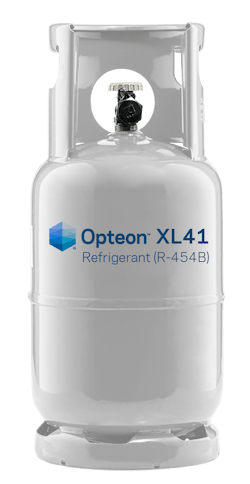
As discussed previously, new A2L mildly flammable refrigerants are starting to make their way into the field. For AC applications, refrigerants such as R-32 and R-454B are now commercial in many areas and numerous OEMs have announced plans to roll out systems with R-454B (Opteon™ XL41) in the coming year. As an HVACR technician, it is prudent to invest some time now to be ready to handle A2L refrigerants – and that starts with the cylinders. Below are some key facts to know.
Colors - as most are aware the industry in gradually transitioning away from color coding of cylinders to designate different refrigerants. With the introduction of new A2L refrigerants like R-454B, or Opteon™ XL41, the cylinders will be a neutral color and the specific refrigerant name will be printed on the jug, as well as the box. R-454B and other A2L cylinders (including recovery) will have a red stripe, band, or top – this is to draw attention, visually, that the contents are flammable. Cylinders and equipment will also be labeled with an A2L symbol/pictogram, to make users aware of its flammability classification.
With the introduction of new A2L refrigerants like R-454B, or Opteon™ XL41, the cylinders will be a neutral color and the specific refrigerant name will be printed on the jug, as well as the box.
Left Hand Threads (LHT) – many cylinders will have a left-hand thread to provide another point of differentiation and help ensure safe use so that A2L’s are only used in systems designed for A2L’s. Remember, A2L’s cannot be used as a retrofit gas, or in systems not designed for them. Adaptors for use connecting A2L cylinders with approved tools, gauges, etc. are already available on the market.
Pressure Relief Device (PRD) – the pressure relief devices on A2L cylinders will be transitioned to pressure activated valves, that in case of over pressure will open to relieve excess pressure and then reseal. This ‘burping” action will safely lower cylinder pressure to a safe level while avoiding loss of the entire contents. This is an improvement over legacy generations of rupture discs, which would release the entire cylinder contents if activated.
Cylinder Storage – this will be discussed in more detail in a future episode but in most cases, storage of cylinders in service vans should not change. For shops or other facilities which may manage larger numbers of cylinders, the rules for A2L storage have been updated. A useful resource is www.ahrinet.org/advocacy/safe-refrigerant-transition-task-force.
Removing Liquid from Cylinders – just like R-410A, R-454B is a two-component blend with a slight temperature glide. It is still best practice to remove refrigerant from the cylinder as a liquid, either thru a liquid dip tube if equipped, or by inverting the jut when charging. Once removed from the cylinder the blend can be ‘flashed’ to vapor thru the charging lines into the system.
In my next column, I'll discuss other important aspects of getting “A2L Ready” – namely any changes coming for the tools and the service trucks that are used every day in serving our customers.
About the Author
Charles Allgood
Technical Fellow with Chemours
Charles “Dr. Chuck” Allgood holds a PhD in chemistry, has more than 30 years of experience in the HVACR industry, and is a respected speaker at many industry events. In addition to Chemours, he’s worked for the National Institute of Standards and Technology. Dr. Allgood has held a variety of research, development, business, technical service, training, and applications development positions with Chemours. Most recently, he has focused on the development of low-GWP refrigerants—including Chemours Opteon™ brand refrigerants—and educating industry professionals about the changing regulatory landscape and A2L refrigerants on the market.
